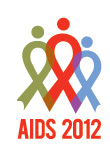 Follow-up data from HIV Prevention Trials Network Study 052 (HPTN 052) show that HIV-serodiscordant couples, in which the positive partner is receiving antiretroviral (ARV) therapy, are no more likely to abandon safer sex practices over time, according to a report presented Monday, July 23, at the XIX International AIDS Conference (AIDS 2012) in Washington, DC.
Follow-up data from HIV Prevention Trials Network Study 052 (HPTN 052) show that HIV-serodiscordant couples, in which the positive partner is receiving antiretroviral (ARV) therapy, are no more likely to abandon safer sex practices over time, according to a report presented Monday, July 23, at the XIX International AIDS Conference (AIDS 2012) in Washington, DC.
The researchers, led by Kenneth Mayer, MD, of Boston’s Fenway Community Health Center, also reported that viral loads remained suppressed in the vast majority of the HIV-positive partners during the two-year follow-up period.
HPTN 052, which began in April 2005, enrolled 1,763 HIV-serodiscordant couples, most of whom (97 percent) were heterosexual. The purpose was to measure whether immediate versus delayed use of ARV therapy by the HIV-positive partner would reduce transmission of the virus to the negative partner. The study was also meant to evaluate whether beginning ARV treatment earlier would benefit the health of the HIV-positive partner.
In the large international trial, 886 HIV-positive participants were randomized to start ARV therapy right away (the immediate treatment group), while 877 waited until their CD4s dropped to 250 or they developed an AIDS-related illness (the delayed treatment group).
In May 2011, the study reported initial success, showing for the first time that starting HIV treatment immediately provided as much as a 96 percent reduction in the chance that the negative partner in a monogamous relationship would contract HIV from a positive partner.
But longer-term results of early start for ART remained to be seen. And with adherence—people’s ability to take their HIV meds consistently without missing doses—posing one of the major challenges for HIV treatment, further results of HPTN 052 could be of great importance. Moreover, HPTN 052 included counseling on safer sex and condom use. If the couples avoided unprotected sex during the first years of HPTN 052, but their condom use dwindled over time, later numbers could potentially show less promise.
Ninety-one percent of participants in the early treatment group had suppressed viral loads at the two-year mark, Mayer and his colleagues reported, compared with 22 percent of those in the delayed treatment group.
As for safer sex practices, Mayer and his colleagues showed that at the start of the trial, 4 percent of people living with HIV in the early treatment group and nearly 6 percent in the delayed arm self-reported unprotected vaginal intercourse (UVI) with their primary partner within the past week. At three months, a little under 3 percent of participants in the early group, compared with a full 3 percent in the delayed group, reported UVI. After two years, UVI was still being reported by 3 percent of those in the deferred group, compared with 2 percent of those in the early treatment group.
Instances of continued UVI were more common in couples where the HIV-positive partner was female.
Considering that UVI data are based on patient self-reports, Mayer and his colleagues noted the potential for inaccurately low percentages. “Pregnancies did occur [among participants], and we have to analyze these immaculate conceptions,” Mayer quipped. But, he added, the researchers assume that people’s desire to lie about behavior did not increase over time.
“Participants developed close relationships with the HPTN 052 staff,” Mayer said, “because retention in care was important. There was no attempt to increase the level of safe sex and adherence counseling, but trust was built over time.” That means, he said, that participants were likely to report their behaviors honestly.
Advertisement
Advertisement
Advertisement






Comments
Comments